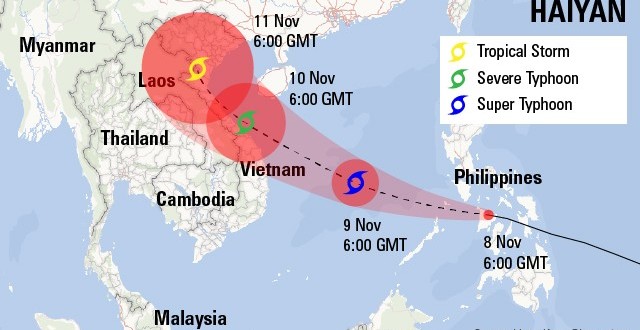The Haiyan typhoon that has hit Philippine has made massive damages and might have well claimed over 10,000 lives in one city alone.
This happens to be one of the worst storms on record to sent giant waves washing away homes, school and airport buildings.
Ferocious winds ravaged several central islands, burying people under tons of debris and leaving corpses hanging from trees.
Regional police chief Elmer Soria said he was briefed by Leyte provincial Gov. Dominic Petilla late Saturday and told there were about 10,000 deaths in the province, mostly by drowning and from collapsed buildings. The governor’s figure was based on reports from village officials in areas where Typhoon Haiyan slammed Friday.
Tacloban city administrator Tecson Lim said that the death toll in the city alone “could go up to 10,000.” Tacloban is the Leyte provincial capital of 200,000 people and the biggest city on Leyte Island.
On Samar Island, which is facing Tacloban, Leo Dacaynos of the provincial disaster office said Sunday that 300 people were confirmed dead in Basey town and another 2,000 are missing.
He said that the storm surge caused sea waters to rise 6 meters when Typhoon Haiyan hit Friday, before crossing to Tacloban.
There are still other towns on Samar that have not been reached, he said, and appealed for food and water. Power was knocked out and there was no cellphone signal, making communication possible only by radio.
Reports from the other four islands were still coming in, so far with dozens of fatalities.
One Tacloban resident said he and others took refuge inside a parked Jeep to protect themselves from the storm, but the vehicle was swept away by a surging wall of water.
“The water was as high as a coconut tree,” said 44-year-old Sandy Torotoro, a bicycle taxi driver who lives near the airport with his wife and 8-year-old daughter. “I got out of the Jeep and I was swept away by the rampaging water with logs, trees and our house, which was ripped off from its mooring.
“When we were being swept by the water, many people were floating and raising their hands and yelling for help. But what can we do? We also needed to be helped,” Torotoro said.
In Torotoro’s village, bodies could be seen lying along the muddy main road, as residents who had lost their homes huddled, holding on to the few things they had managed to save. The road was lined with trees that had fallen to the ground.
Vice Mayor Jim Pe of Coron town on Busuanga, the last island battered by the typhoon before it blew away to the South China Sea, said most of the houses and buildings there had been destroyed or damaged. Five people drowned in the storm surge and three others were missing, he said by phone.
“It was like a 747 flying just above my roof,” he said, describing the sound of the winds. He said his family and some of his neighbors whose houses were destroyed took shelter in his basement.
Reports are still coming-in on the extent of devastation that Haiyan has left behind.
The next in Haiyan’s path is Vietnam, who are preparing themselves for the worst.
 Thfire.com Everyday news that matters
Thfire.com Everyday news that matters 
